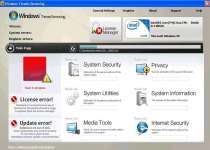Windows Threats Removing
Posted: March 16, 2011
Threat Metric
The following fields listed on the Threat Meter containing a specific value, are explained in detail below:
Threat Level: The threat level scale goes from 1 to 10 where 10 is the highest level of severity and 1 is the lowest level of severity. Each specific level is relative to the threat's consistent assessed behaviors collected from SpyHunter's risk assessment model.
Detection Count: The collective number of confirmed and suspected cases of a particular malware threat. The detection count is calculated from infected PCs retrieved from diagnostic and scan log reports generated by SpyHunter.
Volume Count: Similar to the detection count, the Volume Count is specifically based on the number of confirmed and suspected threats infecting systems on a daily basis. High volume counts usually represent a popular threat but may or may not have infected a large number of systems. High detection count threats could lay dormant and have a low volume count. Criteria for Volume Count is relative to a daily detection count.
Trend Path: The Trend Path, utilizing an up arrow, down arrow or equal symbol, represents the level of recent movement of a particular threat. Up arrows represent an increase, down arrows represent a decline and the equal symbol represent no change to a threat's recent movement.
% Impact (Last 7 Days): This demonstrates a 7-day period change in the frequency of a malware threat infecting PCs. The percentage impact correlates directly to the current Trend Path to determine a rise or decline in the percentage.
| Threat Level: | 10/10 |
|---|---|
| Infected PCs: | 5 |
| First Seen: | March 16, 2011 |
|---|---|
| Last Seen: | January 8, 2020 |
| OS(es) Affected: | Windows |
 The oddly-named Windows Threats Removing program isn't a legitimate security product, but instead a rogue security application that tries to pull one over the user through fake warnings. Windows Threats Removing is a clone of many other threats and uses the same worn-out bullying contrivances of bad system alerts and even worse scanner results. Having Windows Threats Removing on your computer can't help your PC, only harm it, so you shouldn't show any trepidation in deleting Windows Threats Removing before your poor computer suffers even worse attacks.
The oddly-named Windows Threats Removing program isn't a legitimate security product, but instead a rogue security application that tries to pull one over the user through fake warnings. Windows Threats Removing is a clone of many other threats and uses the same worn-out bullying contrivances of bad system alerts and even worse scanner results. Having Windows Threats Removing on your computer can't help your PC, only harm it, so you shouldn't show any trepidation in deleting Windows Threats Removing before your poor computer suffers even worse attacks.
Windows Threats Removing is a Rogue Threat in Collusion with Trojans
The Windows Threats Removing family of rogue security programs traditionally uses the fake Microsoft Security Essentials Alert Malware to get into a PC. This Trojan pretends to be part of Windows and shows the following alert:
Microsoft Security Essentials Alert
Potential Threat Details
Microsoft Security Essentials detected potential threats that might compromise your private or damage your computer. Your access to these items may be suspended until you take an action. Click 'show details' to learn more.
If you see the above message, you should immediately take steps to scan your computer and remove all possible threats. Installing the rogue security program payload that this Trojan carries will only cause your PC to come out worse for the wear, and the Trojan may try to install Windows Threats Removing even if you don't consent!
Should Windows Threats Removing infect your PC, you'll be forced to see Windows Threats Removing open up every single time you start Windows, since the malware makes startup-based changes in your Windows Registry. Windows Threats Removing will regularly show scans that display unreal infection results, as well as making false alerts like these:
System component corrupted!
System reboot error has occurred due to lsass.exe system process failure.
This may be caused by severe malware infections.
Automatic restore of lsass.exe backup copy completed.
The correct system performance can not be resumed without eliminating the cause of lsass.exe corruption.
System Security Warning
Attempt to modify register key entries is detected. Register entries analysis is recommended.
Warning!
Name: firefox.exe
Name: c:\program files\firefox\firefox.exe
Application that seems to be a key-logger is detected. System information security is at risk. It is recommended to enable the security mode and run total System scanning.
The last message is particularly troublesome since Windows Threats Removing may use it to block any type of program, especially ones Windows Threats Removing deems threatening to itself. Besides web browser problems, Windows Threats Removing may also cause you to experience dysfunction in your security products, anti-virus scanners and Windows tools. Windows Threats Removing will even show you fake scores that rate aspects of your system security – always low scores, because the rogue security program isn't even trying to analyze your system in the first place!
Are You Ready to Remove the Real Threat?
Since Windows Threats Removing is just a copy of other known threats like Windows Troubles Remover and Windows Remedy, deleting Windows Threats Removing can be done by most quality anti-malware programs. To eliminate any chances of failure, you should only try to remove Windows Threats Removing after making certain that no malware is running and that your security software is fully up to date.
Using Safe Mode is required to stop Windows Threats Removing from launching itself in most cases. The networking-enabled variant of this mode will allow you access the Internet with less chance of Windows Threats Removing or other malware hijacking your web browser, should you need to download updates or software. As long as you start your system scan the right way, Windows Threats Removing shouldn't be able to evade Windows Threats Removing's own destruction.
Technical Details
File System Modifications
Tutorials: If you wish to learn how to remove malware components manually, you can read the tutorials on how to find malware, kill unwanted processes, remove malicious DLLs and delete other harmful files. Always be sure to back up your PC before making any changes.
The following files were created in the system:%AppData%\Microsoft\fmajil.exe
File name: fmajil.exeSize: 2.68 MB (2688512 bytes)
MD5: cc4f6944994baacd82c7f94e0f195550
Detection count: 32
File type: Executable File
Mime Type: unknown/exe
Path: %AppData%\Microsoft
Group: Malware file
Last Updated: January 8, 2020



















Leave a Reply
Please note that we are not able to assist with billing and support issues regarding SpyHunter or other products. If you're having issues with SpyHunter, please get in touch with SpyHunter customer support through your SpyHunter . If you have SpyHunter billing questions, we recommend you check the Billing FAQ. For general suggestions or feedback, contact us.